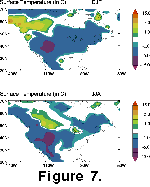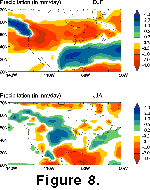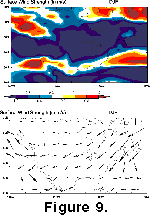PLIOCENE
SENSITIVITY EXPERIMENT
Surface Temperature Difference
and Forcing
 In
response to the altered boundary conditions imposed in the Pliocene sensitivity
experiment, the HadAM3 model predicts reduced surface temperatures compared to
the Pliocene control over wide regions of the USA during both winter and summer
seasons (Figure 7). The magnitude of
this cooling varies spatially with severest cooling (>5ēC) concentrated over
the western United States, associated with the western cordillera. However,
areas in close proximity to the coast, peninsulas (e.g., Florida) and bays
(e.g., Hudson Bay) do not exhibit a cooling trend. This is due to the warmer SST
imposed from the PRISM2 data set. This model suggests that in these regions the
simulated warming observed from the Pliocene present-day control experiment
are solely attributable to the warmer Pliocene SST. Conversely, the increase in
Northern Hemisphere terrestrial ice and snow cover combined with the regional
specified increase (~50%) in the elevation of the North American western
cordillera primarily drove the cooler temperatures over western and central
parts of the USA observed in the Pliocene sensitivity experiment.
In
response to the altered boundary conditions imposed in the Pliocene sensitivity
experiment, the HadAM3 model predicts reduced surface temperatures compared to
the Pliocene control over wide regions of the USA during both winter and summer
seasons (Figure 7). The magnitude of
this cooling varies spatially with severest cooling (>5ēC) concentrated over
the western United States, associated with the western cordillera. However,
areas in close proximity to the coast, peninsulas (e.g., Florida) and bays
(e.g., Hudson Bay) do not exhibit a cooling trend. This is due to the warmer SST
imposed from the PRISM2 data set. This model suggests that in these regions the
simulated warming observed from the Pliocene present-day control experiment
are solely attributable to the warmer Pliocene SST. Conversely, the increase in
Northern Hemisphere terrestrial ice and snow cover combined with the regional
specified increase (~50%) in the elevation of the North American western
cordillera primarily drove the cooler temperatures over western and central
parts of the USA observed in the Pliocene sensitivity experiment.  Therefore,
the primary forcing mechanisms for the simulated warmer conditions in the
Pliocene present-day control experiment are reduced Northern Hemisphere
terrestrial ice and snow cover (via an ice albedo feedback) and the lowered
elevation of the western cordillera of North America.
Therefore,
the primary forcing mechanisms for the simulated warmer conditions in the
Pliocene present-day control experiment are reduced Northern Hemisphere
terrestrial ice and snow cover (via an ice albedo feedback) and the lowered
elevation of the western cordillera of North America.
Precipitation/Wind Strength
Difference and Forcing
 Overall,
the HadAM3 model predictions for the Pliocene sensitivity experiment suggest a
pattern of reduced precipitation levels over the USA for the Pliocene
sensitivity experiment (Figure 8). The
largest reductions are observed during the winter (DJF) season in a latitudinal
range corresponding to the westerly wind belt. This reduction in precipitation
is generated by a number of feedback mechanisms. Increased Northern Hemisphere
snow and ice cover, combined with the increased elevation of the western
cordillera of North America, reduces surface temperatures, evaporation, and the
moisture available for precipitation. Enhanced terrestrial ice cover and lower
surface temperatures, which occur generally in the Northern Hemisphere, weaken
the Icelandic low and Azores high-pressure systems. This has the effect of
weakening the moisture-bearing westerly wind belt in the Pliocene sensitivity
experiment (Figure 9). Therefore,
increased precipitation levels simulated for the Pliocene present-day
control experiment for the region result from reduced snow and ice cover in the
Northern Hemisphere and the reduced elevation of the western cordillera of North
America.
Overall,
the HadAM3 model predictions for the Pliocene sensitivity experiment suggest a
pattern of reduced precipitation levels over the USA for the Pliocene
sensitivity experiment (Figure 8). The
largest reductions are observed during the winter (DJF) season in a latitudinal
range corresponding to the westerly wind belt. This reduction in precipitation
is generated by a number of feedback mechanisms. Increased Northern Hemisphere
snow and ice cover, combined with the increased elevation of the western
cordillera of North America, reduces surface temperatures, evaporation, and the
moisture available for precipitation. Enhanced terrestrial ice cover and lower
surface temperatures, which occur generally in the Northern Hemisphere, weaken
the Icelandic low and Azores high-pressure systems. This has the effect of
weakening the moisture-bearing westerly wind belt in the Pliocene sensitivity
experiment (Figure 9). Therefore,
increased precipitation levels simulated for the Pliocene present-day
control experiment for the region result from reduced snow and ice cover in the
Northern Hemisphere and the reduced elevation of the western cordillera of North
America.

 In
response to the altered boundary conditions imposed in the Pliocene sensitivity
experiment, the HadAM3 model predicts reduced surface temperatures compared to
the Pliocene control over wide regions of the USA during both winter and summer
seasons (Figure 7). The magnitude of
this cooling varies spatially with severest cooling (>5ēC) concentrated over
the western United States, associated with the western cordillera. However,
areas in close proximity to the coast, peninsulas (e.g., Florida) and bays
(e.g., Hudson Bay) do not exhibit a cooling trend. This is due to the warmer SST
imposed from the PRISM2 data set. This model suggests that in these regions the
simulated warming observed from the Pliocene present-day control experiment
are solely attributable to the warmer Pliocene SST. Conversely, the increase in
Northern Hemisphere terrestrial ice and snow cover combined with the regional
specified increase (~50%) in the elevation of the North American western
cordillera primarily drove the cooler temperatures over western and central
parts of the USA observed in the Pliocene sensitivity experiment.
In
response to the altered boundary conditions imposed in the Pliocene sensitivity
experiment, the HadAM3 model predicts reduced surface temperatures compared to
the Pliocene control over wide regions of the USA during both winter and summer
seasons (Figure 7). The magnitude of
this cooling varies spatially with severest cooling (>5ēC) concentrated over
the western United States, associated with the western cordillera. However,
areas in close proximity to the coast, peninsulas (e.g., Florida) and bays
(e.g., Hudson Bay) do not exhibit a cooling trend. This is due to the warmer SST
imposed from the PRISM2 data set. This model suggests that in these regions the
simulated warming observed from the Pliocene present-day control experiment
are solely attributable to the warmer Pliocene SST. Conversely, the increase in
Northern Hemisphere terrestrial ice and snow cover combined with the regional
specified increase (~50%) in the elevation of the North American western
cordillera primarily drove the cooler temperatures over western and central
parts of the USA observed in the Pliocene sensitivity experiment.  Therefore,
the primary forcing mechanisms for the simulated warmer conditions in the
Pliocene present-day control experiment are reduced Northern Hemisphere
terrestrial ice and snow cover (via an ice albedo feedback) and the lowered
elevation of the western cordillera of North America.
Therefore,
the primary forcing mechanisms for the simulated warmer conditions in the
Pliocene present-day control experiment are reduced Northern Hemisphere
terrestrial ice and snow cover (via an ice albedo feedback) and the lowered
elevation of the western cordillera of North America.